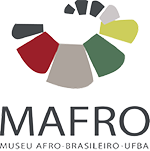O Som do Silêncio: Ecos e Rastros Documentais de Vinte e Seis Esculturas Afro da Coleção Estácio de Lima
Enviado por mafro em sex, 26/04/2019 - 12:44Autora: Gala, Dora.
Esta dissertação apresenta os resultados de uma investigação que teve como campo o Museu Afro-Brasileiro da Universidade Federal da Bahia e a Coleção Estácio de Lima, com o objetivo de produzir conhecimento e organizar as informações obtidas sobre vinte e seis esculturas da citada Coleção em uma abordagem etno-estética. A discussão que se apresenta como pano de fundo é baseada em estudos da cultura material em museus, a antropologia da arte, a análise de categorias ocidentais utilizadas para tratar os objetos etnográficos e o estudo de termos. Nesta pesquisa, realizada por meio de análises bibliográfica e documental, recorremos a inventários, catálogos e fichas de registro de objetos e instrumentos de controle de acervo e ao Manual de Normas: Documentando Acervos Africanos, com intenção de mapear práticas e tendências da área e compilar os termos recorrentes a objetos africanos e afro-brasileiros, compondo um esboço de glossário para esses acervos etnográficos, que constam em apêndice ao final deste trabalho. A análise imagética teve por objetivo encontrar indícios que permitissem inferências e associações estilísticas, contribuindo para a interpretação das esculturas, sendo realizada em banco de imagens, catálogos de museus e de coleções de arte africana, sites de museus, objetos expostos em instituições museológicas e por meio de depoimento oral. Disso resultou a iconografia das vinte e seis esculturas e a iconologia de algumas delas para as quais foram encontrados registros de sua história em reportagens de jornais locais. Com base no conhecimento construído acerca das esculturas e respeitando a polissemia dos objetos foram estabelecidas categorias possíveis para a organização da informação ao final da análise e interpretação das mesmas. A investigação da trajetória institucional da Coleção Estácio de Lima apontou as controvérsias e incertezas que cercam sua formação e o muito que ainda deverá ser investigado sobre ela; destacou a necessidade de que os acervos etnográficos sejam estudados também enquanto representantes das práticas e discursos do museu ao longo do tempo e revelou a ainda frágil estrutura da documentação museológica enquanto prática essencial ao exercício da Museologia.
This thesis presents the results of an investigation that had as fieldwork the Afro-Brazilian Museum of the Federal University of Bahia and Estacio de Lima Collection and aimed to produce knowledge and organize information gathered on the twenty-six sculptures of the mentioned collection in an ethno-aesthetic approach. The backdrop discussion is based in material culture studies in museums, anthropology of art, analysis of Western categories employed to treat ethnographic objects and the study of terms. This survey was conducted through bibliographical and documentary analysis. For this we turned to inventories, catalogs, registration forms of objects and collection's records and the Policy Manual: Documenting African Archives, intending to map practices and trends in the area and compile a recurring terminology to African and Afro-Brazilian objects, composing a preliminary study of a glossary on these ethnographic collections which is listed in the appendix at the end of this work. The imagery analysis aimed to find evidence that would allow inferences and stylistic associations contributing to the interpretation of the sculptures and it was carried out using image databases, catalogs of museums and African art collections, museums sites, objects displayed in museum institutions and through oral testimony. This resulted in the iconography of the twenty-six sculptures and the iconology of some of them whose records of their history were found in reports of local newspapers. Based on the knowledge built about the sculptures and respecting the polysemy of objects, possible categories were established to organize the information in the conclusion of the analysis and interpretation. The investigation of the institutional trajectory of Estacio de Lima Collection pointed out the controversy and uncertainty surrounding its formation and how much it should still be investigated; It indicated the need to study ethnographic collections because they also represent the practices and discourses of the museum over the time and revealed the still fragile structure of the museological documentation while being an essential practice to exercise the Museology.
